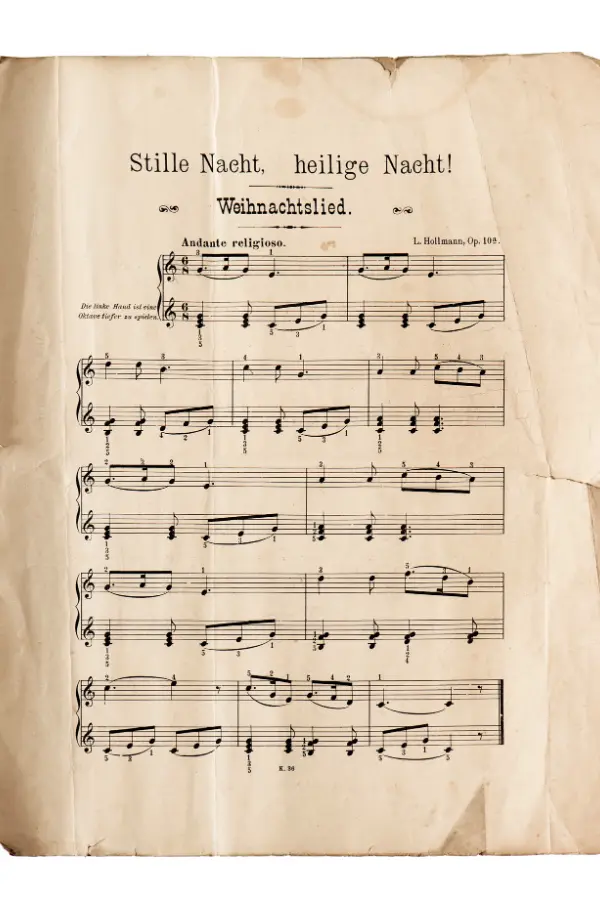- Home
- German Holidays and Customs
- Christmas Eve
By: Eran Fulson / Writer, Traveler, Explorer of Good Food & Historic Streets / For 15+ years, I’ve lived in Canada and Wales, road-tripped across North America, and trekked through Europe’s mountains, cities, and coastlines. Now, I help travelers uncover hidden gems and culture-rich destinations in Germany with firsthand insights and practical tips.
Christmas Eve in Germany: A Dive into the Festive Spirit
While the rest of the world waits for Christmas morning, Christmas Eve in Germany is the main event. Germans embrace Heiligabend (Christmas Eve) with a sense of reverence and attention to detail, making it a truly special occasion during the Christmas season.

I'll draw from my own experiences and regional traditions for as general an overview as one can do. Bear in mind, every family has their own particular flavor of Christmas and will vary from home to home.
On this page:
The Main Event: Holy Evening (Heiligabend)

First things first: Germans take Christmas Eve very seriously. This isn’t some prelude to the big day. No, Heiligabend (Christmas Eve) is the main event. Candlelit church services, elaborate dinners, and unwrapping presents under a beautifully decorated Christmas tree are all part of the experience.
In many families, the tree is only decorated on Christmas Eve, adding to the anticipation and sense of occasion. Although, this could also be for the practicality of not having to sweep up pine needles every day for a month.
The Feast: More Than Just Potato Salad

Speaking of traditions, let’s talk about food. While some families keep it simple with Kartoffelsalat and Würstchen (potato salad and sausages), others go all out with festive dishes like roasted goose, red cabbage, and dumplings—staples of a traditional Christmas Eve meal.
In Eastern Germany and Catholic areas, carp is often served, reflecting historical fasting practices.
And, of course, Christmas cookies (Plätzchen), meticulously baked in the weeks leading up to Christmas time, take center stage for dessert. And Stollen—can't forget Dresden's contribution to the Christmas calories.
The Mysterious Christkind
In many parts of Germany, Santa Claus doesn’t bring the presents. Instead, it’s the Christkind (Christ Child), a figure representing the spirit of Christmas. The Christkind is often imagined as a celestial being who quietly delivers gifts, adding an air of mystery and magic to the evening.
In some regions, local parades feature a young girl dressed as the Christkind, bringing this tradition to life. This is a unique aspect of German Christmas traditions.
This tradition dates back to the Reformation, when Martin Luther introduced the Christkind to shift the focus away from Saint Nicholas. Children often write letters to the Christkind, which are left on the windowsill during Advent.
Silent Night, Holy Evening

No Christmas Eve in Germany is complete without singing Stille Nacht (Silent Night). This beloved Christmas carol is sung in living rooms and churches alike, often by candlelight. The serene melody and meaningful lyrics create a reflective and heartfelt moment. Except for that one relative singing offkey with not-so-silent gusto.
The Urban Myth-ical Pickle

Here’s an unusual tidbit: the Weihnachtsgurke (Christmas pickle). Legend has it that a glass pickle ornament is hidden in the tree, and the first person to find it receives an extra gift and/or good luck.
However, this custom is largely unknown in Germany and appears to be more popular in the United States. Its origins are unclear, but it's largely attributed to early glass Christmas ornaments being imported from Germany to the United States in the early 1900s (and yes, some were allegedly pickle-shaped).
Thus, the fabled gherkin and Germany landed in one unfortunate Christmas pickle conundrum together. Generally to the disdain of Germans. The pickle, however, is quite happy in good company.
Midnight Services and Quiet Reflections

For many, candlelight church services and midnight mass are a cornerstone of Christmas Eve. These services often feature choir performances and the soft glow of candlelight, providing a peaceful and spiritual close to the day. Others prefer to spend the evening at home, reflecting on the day’s celebrations with extended family members.
No Time Like the Present
The German tradition of unwrapping presents on Christmas Eve is actually more tied to the birth of Jesus than anything to do with St. Nicholas. Since Jesus was born at night, his birth is celebrated more closely to that time of day instead of beginning the day with it.
This tradition ties together the Christkind and bell ringing (see the next section). Children would wait outside the room for the Christ Child to leave presents, and ring a bell when finished.
Though, more generally speaking, after the traditional Christmas Eve meal, family members gather around the Christmas tree, often in their finest attire, to exchange gifts.
Apparently, I was often an exception to this finest attire rule...

Things You Might Not Know

Even seasoned celebrants may not know about these unique aspects of German Christmas celebrations:
- Spiders on the Tree? The origins for this is up for debate. Whether it began in Ukraine or Germany, it’s considered good luck to hang a spider ornament on the Christmas tree. The legend ties back to a story about a widowed mother who was too poor to decorate her Christmas tree, so some helpful spiders spun elaborate ornamental webs.
- The Bell Ringing Tradition: In many families, a small bell signals that the Christkind has come and gone, marking the moment to open Christmas presents. This charming ritual adds to the festive atmosphere.
- TV Classics: No Christmas Eve is complete without beloved holiday films like Sissi, the 1950s trilogy about the Austrian empress, or Drei Haselnüsse für Aschenbrödel (Three Wishes for Cinderella), which have become staples of German holiday traditions.
Wrapping Up Christmas Eve in Germany
Christmas Eve in Germany is a harmonious blend of tradition, celebration, and reflection. Whether it’s through singing carols, sharing a festive meal, or enjoying family time, the day holds a special place in the hearts of many.
From advent calendars and wreaths to famous Christmas markets and festive decorations, every detail contributes to the allure of the season. Frohe Weihnachten!


